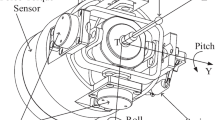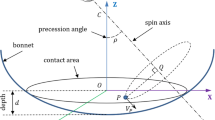Abstract
When the non-standard customized brush roller tool is used for robotic grinding of large-scale components, the clamping and positioning error of the brush roller at the end of the robot is extremely easy to cause misalignment at the brush roller-workpiece contact interface, which will affect the machining accuracy and surface quality. In order to ensure the parallel contact between the brush roller and the workpiece surface during the machining process, a calculation model of the angular misalignment at the brush roller-workpiece contact interface is proposed based on the elastic contact force perception, and then the accurate positioning of the robot end brush roller is realized by a fast compensation method. Firstly, according to the geometric force relationship between the brush roller and the workpiece, as well as the determined brush roller material property parameters, the estimation model of angular misalignment is established. Secondly, both the axial force and normal torque at the time of initial contact detected by the force-controlled sensor are regarded as the input parameters in the model. Furthermore, the calculated brush roller-workpiece contact offset is used as the geometric error compensation amount, and the brush roller is deflected to achieve error compensation by the robot RAPID program control command. The finite element simulation results are compared with the theoretical calculation values, and the average relative error is 15.1%. The experiment on robotic grinding and brushing of high-speed rail body indicates that the compensated angle can be reduced to 0.024° from an average of 0.179° before compensation, coupled with uniform material removal depth. The proposed method can significantly improve the contour accuracy of large-scale components.














Similar content being viewed by others
Data availability
The data and materials of this manuscript are available from the corresponding author on reasonable request.
Code availability
Not applicable.
References
Zhu D, Feng X, Xu X, Yang Z, Li W, Yan S (2020) Ding H. Robotic grinding of complex components: a step towards efficient and intelligent machining – challenges, solutions, and applications. Robot Cim-Int Manuf 65:101908.
Li W, Xie H, Yin Z, Ding H (2021) The research of geometric error modeling of robotic machining: I spatial motion chain and error transmission. J Mech Eng 57(7):154–168
Li W, Xie H, Yin Z, Ding H (2021) The research of geometric error modeling of robotic machining: II parameter identification and pose optimization. J Mech Eng 57(7):169–184
Jiang Z, Huang M, Tang X, Guo Y (2021) A new calibration method for joint-dependent geometric errors of industrial robot based on multiple identification spaces. Robot Cim-Int Manuf 71(1):102175
Luo G, Zou L, Wang Z, Lv C, Huang Y (2021) A novel kinematic parameters calibration method for industrial robot based on Levenberg-Marquardt and Differential Evolution hybrid algorithm. Robot Cim-Int Manuf 71(1):102165
Li W, Xie H, Zhang G, Yan S, Yin Z (2015) Hand–eye calibration in visually-guided robot grinding. IEEE Trans Cybern 46(11):2634–2642
Li M, Du Z, Ma X, Dong W, Gao Y (2021) A robot hand-eye calibration method of line laser sensor based on 3D reconstruction. Robot Cim-Int Manuf 71(2017):102136
Xu X, Zhu D, Wang J, Yan S, Han D (2018) Calibration and accuracy analysis of robotic belt grinding system using the ruby probe and criteria sphere. Robot Cim-Int Manuf 51:189–201
Sun Y, Giblin D, Kazerounian K (2009) Accurate robotic belt grinding of workpieces with complex geometries using relative calibration techniques. Robot Cim-Int Manuf 25(1):204–210
Zhu D, Xu X, Jiang C, Li W (2021) Research progress in robotic grinding technology for complex blades. Acta Aeronautica et Astronautica Sinica 42(10):524265
Ren Y, Yin S, Zhu J (2012) Calibration technology in application of robot-laser scanning system. Opt Eng 51(11):114204
Ma L, Bazzoli P, Sammons P, Landers R, Bristow D (2018) Modeling and calibration of high-order joint-dependent kinematic errors for industrial robot. Robot Cim-Int Manuf 50:153–167
Luo X, Xie F, Liu X, Xie Z (2021) Kinematic calibration of a 5-axis parallel machining robot based on dimensionless error mapping matrix. Robot Cim-Int Manuf 70:102115
Nubiola A, Bonev I (2013) Absolute calibration of an ABB IRB 1600 robot using a laser tracker. Robot Cim-Int Manuf 29(1):236–245
Zhao D, Dong C, Guo H, Tian W (2018) Kinematic calibration based on the multicollinearity diagnosis of a 6-DOF polishing hybrid robot using a laser tracker. Math Probl Eng 5602397
Huang T, Zhao D, Yin F, Tian W, Chetwynd D (2019) Kinematic calibration of a 6-DOF hybrid robot by considering multicollinearity in the identification Jacobian. Mech Mach Theory 131:371–384
Boby R, Klimchik A (2021) Combination of geometric and parametric approaches for kinematic identification of an industrial robot. Robot Cim-Int Manuf 71:102142
Cen L, Melkote S, Castle J, Appelman H (2016) A wireless force-sensing and model-based approach for enhancement of machining accuracy in robotic milling. IEEE-ASME T Mech 21(5):2227–2235
Latifinavid M, Konukseven E (2017) Hybrid model based on energy and experimental methods for parallel hexapod-robotic light abrasive grinding operations. Int J Adv Manuf Technol 93(9–12):3873–3887
Latifinavid M, Donder A, Konukseven E (2018) High-performance parallel hexapod-robotic light abrasive grinding using real-time tool deflection compensation and constant resultant force control. Int J Adv Manuf Technol 96(9–12):3403–3416
Ye C, Yang J, Zhao H, Ding H (2021) Task-dependent workpiece placement optimization for minimizing contour errors induced by the low posture-dependent stiffness of robotic milling. Int J Mech Sci 205:106601
Wang Q, Wang W, Zheng L, Yun C (2021) Force control-based vibration suppression in robotic grinding of large thin-wall shells. Robot Cim-Int Manuf 67:102031
Xu X, Chen W, Zhu D, Ding H (2021) Hybrid active/passive force control strategy for grinding marks suppression and profile accuracy enhancement in robotic belt grinding of turbine blade. Robot Cim-Int Manuf 67:102047
Popov V (2010) Contact mechanics and friction: physical principles and applications. Springer-Verlag, Berlin Heidelberg
Qu C, Lv Y, Yang Z, Xu X, Zhu D, Yan S (2019) An improved chip-thickness model for surface roughness prediction in robotic belt grinding considering the elastic state at contact wheel-workpiece interface. Int J Adv Manuf Technol 104(5):3209–3217
Zhu D, Wen Z, Xi W, Zhang M (2020) Parametric evaluation method for surface texture of high-speed railway body in white drawing. J Huazhong Univ Sci Technolog (Natural Science Edition) 48(11):48–53
Funding
This study is financially supported by the National Nature Science Foundation of China (No. 51975443) and the Hubei Province Key R&D Program (No. 2020BAA025).
Author information
Authors and Affiliations
Contributions
Xiaozhi Feng: conceptualization, investigation, writing—original draft, writing—review and editing, methodology. Rui Lv: methodology, validation, writing. Chen Qian: methodology, writing—reviewing and editing. Yudi Wang: investigation, writing—reviewing and editing. Linli Tian: methodology, writing—reviewing and editing. Dahu Zhu: funding acquisition, writing—reviewing and editing.
Corresponding author
Ethics declarations
Ethics approval
The research contents of the article do not violate ethics.
Consent to participate
The research does not involve human participants or animals, and the authors warrant that the manuscript fulfills the ethical standards of the journal.
Consent for publication
All authors give consent to publish this manuscript in the International Journal of Advanced Manufacturing Technology.
Competing interests
The authors declare no competing interests.
Additional information
Publisher's Note
Springer Nature remains neutral with regard to jurisdictional claims in published maps and institutional affiliations.
The authors claim that none of the contents in this manuscript has been published or considered for publication elsewhere.
Rights and permissions
About this article
Cite this article
Feng, X., Lv, R., Qian, C. et al. Estimation and compensation of angular misalignment at robot end brush roller-workpiece contact interface via elastic contact force perception. Int J Adv Manuf Technol 121, 367–377 (2022). https://doi.org/10.1007/s00170-022-09282-1
Received:
Accepted:
Published:
Issue Date:
DOI: https://doi.org/10.1007/s00170-022-09282-1




